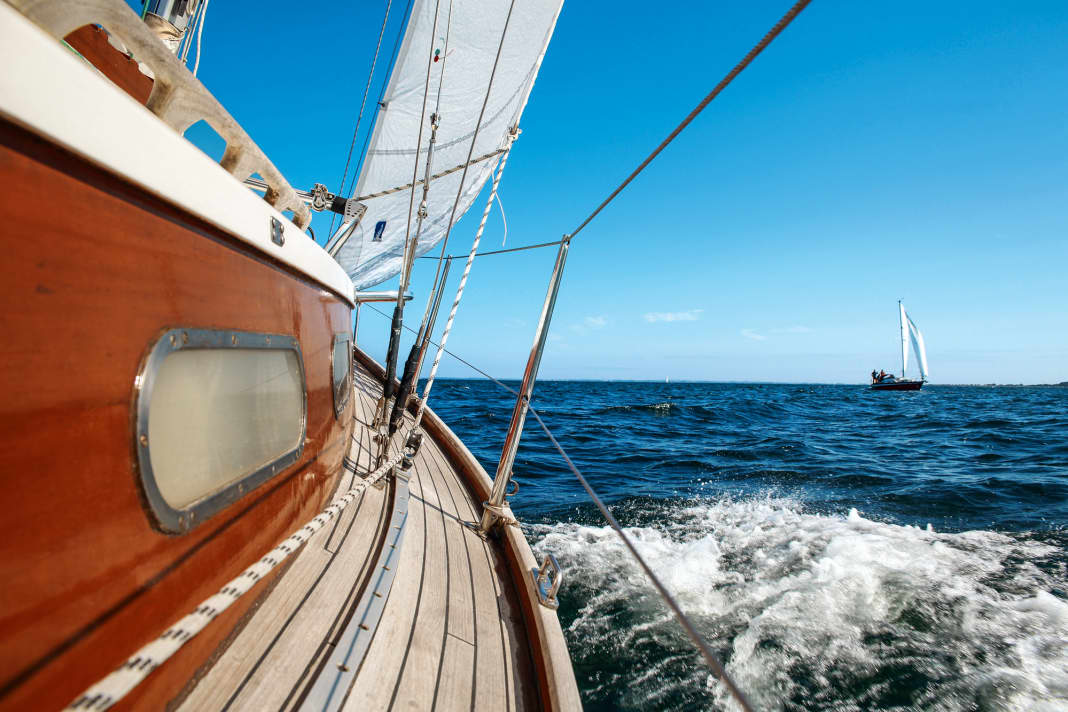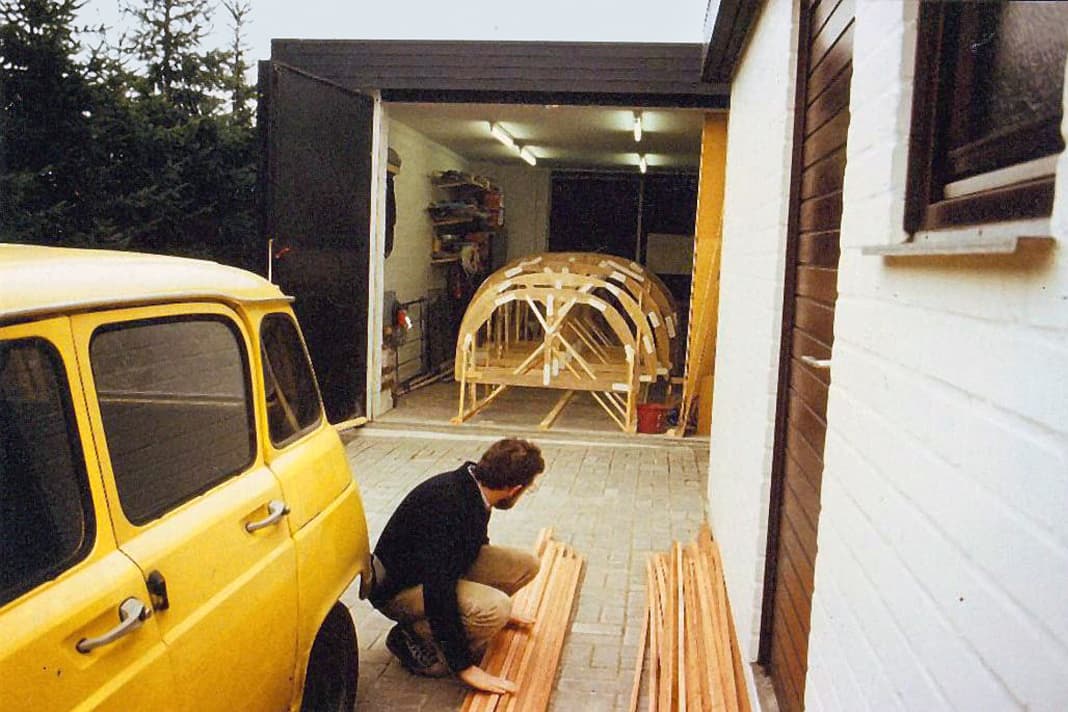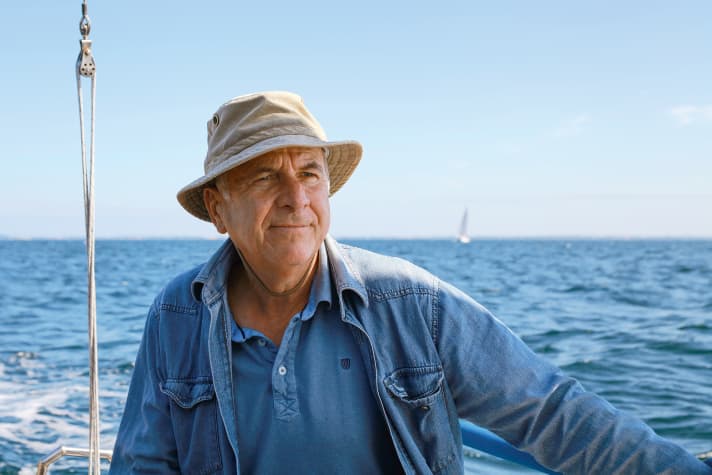





This boat is a floating time capsule, the likes of which are few and far between today. By Christmas 1982, when the "Linea" was launched, the era of wooden boats was finally over. "Very rarely does the nose still encounter the pleasant smell of wood," wrote YACHT at the time, somewhat wistfully. Boats made of plastic and built in large series flooded the market, and many of them were sunshine yellow, bright orange or even fire engine red. Mockers also mentioned the colours bockwurst beige and corneal umbra.
Gone are the days when yachts made of GRP could simply be dismissed as "plastic buckets" or "yoghurt pots". At the same time, the industrialisation of yacht building had made cruising boats affordable for many. Wooden boats were soon considered unaffordable, classic, traditional, exotic - or even outdated.
"People thought that the hull was made of GRP because of its circular shape," recalls Jürgen Sandkuhl, designer and builder of the coastal cruiser "Aegir", today's "Linea". "They were usually amazed when I showed them the planks inside." At most, dinghy cruisers were still built like this. "Customised ships were almost non-existent at the time," says Sandkuhl.
Jürgen Sandkuhl has drawn, designed, built and manufactured
Under the guise of the International Offshore Rule, i.e. the IOR handicap formula, boats with narrow sterns, deliberately bulbous hulls and, in the tonne classes, slow yachts with narrow sterns, bulbous frames and often little stability were created. The rules, which were actually designed for regatta sailing and made it possible for different designs to compete against each other and categorise their performance, also had a formative effect on cruising boats. The IOR formula influenced the development of yacht building well into the 1990s.
Today, many of the GRP boats from the 1980s have disappeared, ravaged by osmosis because the resin was skimped on, the lamination was sloppy and there was simply no knowledge of the chemical-physical processes of the material-killing blistering disease. Plastic boats in particular were not only considered easy to maintain, but also leak-proof and durable.
The "Linea", which is glued together from many strips of wood, has no problems in this respect; even 30 years after her first launch, she has no red spots or moisture damage anywhere, neither in the hull nor on deck. Jürgen Sandkuhl is one of those self-builders who have paid attention to perfection everywhere. He drew, designed, built and manufactured everything on his boat himself - right down to the small metal latch in the hatch to the companionway. And where something had to be bought, such as the paraffin cooker, he at least "optimised" it, as he says. "I have a lot of confidence in myself," assures Sandkuhl, "you can do more than you think!" And he never wanted a GRP boat anyway: "The smell alone!" In the past, as a mechanical engineer at Siemens, he basically built everything, says Sandkuhl, "everything except nuclear power stations and bridges". He even built the Mirror, a two-handed dinghy from England, on which he once learnt to sail.
Construction from the inside out using the Lisoletta method




The boat was built using the so-called Lisoletta construction method. This involves first building a framework of bulkheads and stringers, then the load-bearing interior fittings, and finally the outer skin made of thin strips of plywood; the boat is therefore built from the inside out. Fritz Marggraf (1917-1994) conceived this method, named after his wife, in the 1960s and combined it with lightweight, dimensionally stable hulls that were long in the waterline. Apart from a few regatta successes, it did not catch on, but this was attributed more to his personality than his design. The man was regarded as stubborn and resistant to advice.
"Linea" is created on the side
It took seven years until the 7.50 metre long and 2.50 metre wide coastal cruiser was finally completed in 1988. The shipyard was built next to his house, which is located in a housing estate in Weyhe near Bremen. Not even the squeaky yellow Renault R4 had to give up its place in the garage at first. And when the body needed to be turned over, for example, the neighbours helped. "We live in a ruin," said his wife at the time, and there was no time to work on the house. Sandkuhl proudly reports that he "didn't take a mark out of the budget" for his ship. He earned the money - almost 20,000 Deutschmarks - on the side.
This made the "Aegir" significantly cheaper than many comparable models available at the time: a Bianca 26 or a Contest 25 cost well over 30,000 Deutschmarks, an Albin Vega 27 over 50,000 Deutschmarks.
The 25-foot "Linea" was created using the so-called Lisoletta method by designer Fritz Marggraff: the weight-saving construction method is based on a load-bearing structure made of bulkheads and stringers, which is then planked double-diagonally. The thin plywood panels are bent as a whole and the interior supports the boat. So you don't make a shell first and then painstakingly remove it for a precise fit - instead, you work from the inside out. This principle makes it possible to produce very strong and light hulls in a round bilge. However, although the Lisoletta boats anticipated some design features and were also quite successful in regattas, they never caught on, partly because the required wall thickness of the wood was unnecessarily thicker than with pure moulded gluing.
Storage space miracle "Linea"
Unlike in many modern large-scale production yachts, no space in this ship remains unused; there are drawers and storage compartments everywhere, all of which are seaworthy. In fact, there are so many that even the new owner Jochen Peschke only found some of them after years, as he explains: "The boat is full of little wonders." They can be found as a compartment in the locker or elegantly designed with contrasting mouldings, but also in the footwell of the saloon berths or as a wine holder below deck, right next to the brass lamp. And neatly labelled, in a matching triangular shape, under the benches - for shackles and blocks, screws and nuts, bolts and cotter pins.
You can even make discoveries where there is actually no space: Where the stairs of the companionway (which is also a rubbish bin) meet the drawers of the pantry with its two-burner paraffin cooker, the lowest shelf is designed as a small carousel that can be turned out like in large kitchens, for pots and pans.
Right next to it is a sight glass, which can also be illuminated at the touch of a button to show the diesel level of the 9 hp Yanmar. When folded, the cabin table disappears almost completely next to the mast support, and even the chart table - where you work standing up - can be stowed away on the cabin bulkhead to save space. The foredeck and the separate toilet are separated from the saloon by a wooden folding door, and the mechanism still works perfectly even after 30 years. Even the paintwork below deck is still the same and surprisingly flawless.
Classic look without feeling like a classic car
The boat has four berths, but like many boats of this size, this one is better shared by two people. The backrests in the saloon can be unhinged and reattached to the bulkheads as a leeboard for sleeping at sea. However, the berth under the elegantly laminated deck beams then becomes a little cramped. The crew have to do without headroom, albeit just barely - this was a compromise to keep the coastal cruiser "more ship-like", as Sandkuhl calls it.
He built the entire interior and superstructure in solid and marine plywood and laid traditional teak decking. Everything looks very classic without giving you the feeling that you are sailing a classic car. "However, I should have kept a better eye on the weight below deck," says the man today, adding that, like others at the time, he had made the interior too heavy. In contrast to various other self-builders, he paid strict attention to lightness in the other areas, as stable as the "Linea" is designed: The finished ship weighs less than two tonnes including the engine.
When illustrator Jochen Peschke, who produces and publishes the lovingly designed map series "Die Elbe" and also works for YACHT, saw the ship for the first time, on a cold winter's day in Bremen in 2005, he was immediately enamoured. "It's extremely modern for the time," he enthuses. Yet Peschke, as he later admits, initially had "great reservations" about buying a ship he had designed and built himself. After all, they often have a dubious, if not bad, reputation, and not always without good reason.
Elegant, yet simple, and above all suitable for one-handed use
The two men sit together in the cabin for two hours on their first visit, in frosty temperatures. Peschke buys the boat without having sailed it even once. He gives up a Waarschip 710, the forerunner of the well-known Waarschip Kwarttonners, an IOR quarter-tonner which, like all Waarschips, has a good reputation. But his boat had become a little too simple for him - Peschke was looking for the same thing, only a little more sophisticated. And Sandkuhl now wanted something smaller and less complicated, as he had already been retired for a few years at the time; from then on he sailed dinghies again. He considers the idea of having a large boat in his old age to be a mistake - "stupid", says Sandkuhl.
If it is to be a cruising boat, then it should definitely be single-handed. And Sandkuhl has made no compromises in his design. Even the mast with its 7/8 rig can be raised and lowered without outside help, confirms Peschke, "even in a storm!" There is a rigging strap on board in case you get stuck somewhere or the engine should fail, and a boom for the elegantly curved tiller, which is so long that you can sit under the sprayhood in bad weather or stand in the companionway and still steer comfortably. The tiller can be fixed in place using a very simple mechanism - designed in-house, of course - in lighter winds if you want to do without a real self-steering system. Otherwise, the helmsman sits comfortably on his own teak-panelled outriggers to port and starboard when steering.
Progressive lines ensure light-footedness
"You have to be able to sail the boat on your own," says Sandkuhl. He is someone who no longer wants to bow to any guidelines and wants to be independent, someone who doesn't want to ask anyone for help. And he certainly doesn't want to submit to any technology, because the experienced engineer is still extremely reluctant to trust it. Probably because he spent a long time developing it himself.
Peschke's gamble of taking over the boat without a sea trial paid off. The "Linea" sails amazingly light-footed, almost dinghy-like. But it can't glide, only surf the waves. Even Sandkuhl was initially surprised at how well his design sits on the rudder. This is where you notice the low weight of the boat - and the very progressive lines at the time, as well as the well-profiled keel. The reefing limit is somewhere between four and five wind forces: "The boat can take a lot," says Peschke. The "Linea" also copes well with the sometimes somewhat steep, short Baltic Sea waves. The stern is unusually wide for a boat from that time, but there is a large bathing platform where the current breaks cleanly. The "Linea" with its 23 square metres of sail area is certainly not a performance cruiser, but it is a comfortable cruising boat with a narrow waterline and harmonious, classic shapes that do not look outdated even today.
Lifetime guarantee for "Linea"
How fast is the boat? Well, that's not really the point here. Sandkuhl wanted to sail ahead, but he didn't want to push the things he liked to do in a competition. So he never sailed in regattas. And although Peschke owns a log, he never uses it. Where one might have been installed, on the starboard side next to the companionway hatch, there is now a custom-fit wooden iPhone holder.
Incidentally, Sandkuhl has given the new owner a "lifetime guarantee" for the "Linea". And not as a joke: the builder will return in the autumn to carry out the annual service. Nevertheless, the two gentlemen, who have become close friends, have now reduced the warranty period to 25 years, which means it will expire in 2030. Of course, this has nothing to do with the boat itself. But Jürgen Sandkuhl will be 77 years old this year. His boat is likely to outlive him.
Technical data of the "Linea"
- Design engineer:Jürgen Sandkuhl
- Rigging:7/8 rig
- Building material:Plywood
- Length (over all):7,50 m
- Length (waterline):7,00 m
- Width:2,50 m
- Depth:1,45 m
- Displacement:1,7 t
- Ballast:0,6 t
- Sail area on the wind:23,0 m²
- Spinnaker:35,0 m²
- Berths:4
- Motor:6.6 kW/9.0 hp
The owner of the "Linea"

Hamburg-based Jochen Peschke is known to YACHT readers as the long-standing illustrator of the tips in Skippers magazine. It is therefore not surprising that some of the practical tricks and advice have also found their way onto the "Linea" and that Peschke also reveals details of his boat in the section.
The article appeared in YACHT issue 21/2018 and was revised for the online version.

